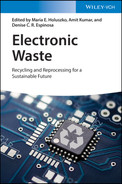Preface
Digitalization has played an essential role in social and technological development globally, while electronic and electrical equipment has become integral to our everyday lives. Digital devices provide broad access to education, instant information, continuous entertainment and contribute to mass communication, thus improving the overall quality of our lives. During the COVID-19 pandemic, the internet allowed us to function and remain a productive society worldwide.
Meanwhile, the life expectancy of most electronic devices, specifically small devices such as cellphones, tablets, and laptops, is getting shorter and shorter, resulting in alarming amounts of e-waste generation. Many discarded electronics are being improperly disposed of, hence posing a significant risk to the environment and human health. With an estimated annual growth of 3–4%, electronic waste is the fastest growing waste stream worldwide, exceeding 50 Mt annually in 2019, while only 20% of the e-waste is collected and recycled globally. The electronic devices have been reported to contain gold and copper grades, significantly exceeding the grades of many operating mines. The existence of precious metals in e-waste provides an economic incentive for recycling. On the other hand, the presence of hazardous substances in e-waste calls for complex reprocessing to decontaminate before its final disposal.
The development of efficient e-waste recycling methods and the recovery of precious metals and critical materials from e-waste are interesting and technically challenging. Furthermore, the informal urban mining of e-waste creates significant social and public health issues. Therefore, there was a need for a comprehensive overview of the current situation with e-waste generation, disposal, regulations, recycling technologies while providing a global perspective.
This book aims to overview the current global situation regarding e-waste, including technological issues with e-waste recycling and recovery of value from e-waste streams. The chapters in this book outline the definition of electronic waste, explore methods for e-waste estimation, identify challenges related to the timely information on e-waste collection and management, and elaborate on the practices in developed and developing countries. The book delivers information on currently used recycling technologies, including physical separation technologies, pyrometallurgy, hydrometallurgy, and biohydrometallurgy, and reviews materials used in the manufacturing of electronics as well as the development of new materials for green-ecological and biodegradable electronics. Additionally, methods and ideas for new practices to facilitate sustainability in the electronics industry are proposed to “close the loop” in industrial production to minimize waste generation and possibly to promote a zero-waste scenario. The book concludes with a chapter on the circular economy in electronics and provides some perspective on the future of electronic waste.
This book was made possible through collaboration between international experts in the field of e-waste recycling. It collates academic and industrial expertise to provide a comprehensive overview of the scope of the problem with electronics worldwide, specifically on their fate as e-waste and the recycling efforts to shed light on the current e-waste paradigm.
| Vancouver, July 2021 | Maria E. Holuszko Amit Kumar Denise C. R. Espinosa |
